Labour Force
- Home
- Statistics
- Labour Market
- Labour Market Information
- Labour Force
Key Statistics of Labour Force in Malaysia, June 2021
Key Statistics of Labour Force in Malaysia, May 2021 9 June 2021
Key Statistics of Labour Force in Malaysia, April 2021 7 May 2021
Key Statistics of Labour Force in Malaysia, March 2021 7 May 2021
Principal Statistics of Labour Force, Malaysia, First Quarter (Q1) 2021 22 April 2021
Labour Force Survey Report, Malaysia, 2020 8 April 2021
Key Statistics of Labour Force in Malaysia, February 2021 Show all release archives
Overview
_v10-01.png)

KEY REVIEWS
- Employed persons by economic sector in June 2021 showed that all sectors registered a decline month-on-month in employment with Services sector posted decreases for the first time after twelve months. The reduction in Services sector was largely in Accommodation and food & beverages services; Real estate; and Wholesale & retail trade activities.
- The largest composition of employed persons was employee’s category with 77.6 per cent. This category reduced by 56.7 thousand persons (-0.5%) to 11.87 million persons as compared to the previous month (May 2021: 11.93 million persons). Meanwhile, own-account workers which comprised mostly of daily income earners working as small business operators such as small retailers; hawkers; sellers in markets and stalls as well as smallholders, recorded an addition of 4.1 thousand persons to 2.50 million persons (May 2021: 2.49 million persons).
- The unemployment rate in June 2021 climbed to 4.8 per cent (May 2021: 4.5%) after fourconsecutive months of decreases. The number of unemployed persons escalated by 40.6 thousand persons (+5.6%) to 768.7 thousand persons (May 2021: 728.1 thousand persons).
- During the month, the number of labour force declined by 32.8 thousand persons to 16.07 million persons (May 2021: 16.10 million persons) and this was the first decrease of labour force recorded since April 2020 as the pandemic hit the country. Accordingly, lower labour force participation rate (LFPR) was registered at 68.3 per cent (May 2021: 68.5%).
- The number of outside labour force in June 2021 continued to increase for the third month, thereby recorded an addition of 58.8 thousand persons (0.8%) to 7.46 million persons (May 2021: 7.40 million persons). The largest category of outside labour force was due to the housework/ family responsibilities which comprised of 47.3 per cent and followed by schooling/ training category with 38.9 per cent.
- The health crisis persists and the country is still combatting the rising number of new daily COVID-19 cases. This has led the economy and labour market continuously experiencing uneven recovery. Therefore, herd immunity is essential towards loosening up the containment measures, thus allowing businesses to resume their operation. The National COVID-19 Vaccination Programme is speeding up the pace hence it may boost the households and businesses confidence to stimulate the economic activity. Moreover, various initiatives are also funded to support business continuity through Pakej Pelindungan Rakyat dan Pemulihan Ekonomi (PEMULIH). With these programmes, the economy and labour market activities may rebound, not considering the new and more lethal COVID-19 variants.
CHALLENGING LABOUR FORCE SITUATION OBSERVED IN JUNE 2021 AS THE COUNTRY CONTINUED TO ENDEAVOUR IN FLATTENING THE SURGE OF NEW DAILY COVID-19 CASES
A nationwide “full lockdown” was imposed from 1 June to 14 June, and then extended to 28 June. During this phase, only essential services were allowed to operate including activities related to food & beverages, utilities, security, health & medical care, transportation, banking, communications and essential construction activities. Travelling restrictions were allowed up to 10 kilometres radius and all business activities could only be operated until 8.00 pm.
On 15 June, the Government announced the National Recovery Plan (NRP) comprising of four phases which would be imposed based on the number of new daily cases, vaccination rate and COVID-19 patient admission to Intensive Care Units (ICU). Phase 1 of NRP is similar to the conditions of the total lockdown, while in Phase 4 all economic activities will resume. In June 2021, the entire nation was in total lockdown as new daily cases exceeded the average of 5,000 while daily COVID-19 mortality was above 100. For the record, June last year, the whole country was under Recovery Movement Control Order (MCO) except for certain area which was in Restricted MCO. During this period, almost all economic sectors were allowed to operate including education, social and religious activities albeit strict operating procedures whereas inter-state travelling activities were allowed, unlike the first MCO implemented during March until May last year.
A challenging labour force situation was observed in June 2021 as the country continued to endeavour in flattening the surge of new daily COVID-19 cases. Some of the labour force had moved into inactivity which led the number of labour force dropped. Higher unemployment was recorded while employed persons reduced during the month. In addition, Malaysia’s Leading Index (LI) which anticipates the economic direction in the near future shrank by 2.9 per cent month-on-month in May 2021 (April 2021: - 1.2%). As for the year-on-year comparison, LI posted an increase of 6.9 per cent as compared to the previous month (April 2021: 15.7%). In the meantime, the monthly indicators for both exports and imports registered a positive month-on-month growths of 14.3 per cent and 5.9 per cent respectively.
The Labour Force Report for June 2021 describes the labour supply situation as the country entered the sixteenth month of various MCO phases. The report will elaborate on the month-on-month changes to examine the immediate effects of the MCO to contain the spread of COVID-19. Users are advised to interpret the monthly statistics with caution since they are non-seasonally adjusted. In addition, annual changes from the same month of the previous year are also reported.
Employed persons dipped by 0.5 per cent to record 15.30 million persons
In June 2021, employed persons dipped by 0.5 per cent (-73.3 thousand persons) to record 15.30 million persons (May 2021: 15.37 million persons) after registering a marginal increase in the previous month. Nevertheless, year-on-year basis, the positive trend was continued for four consecutive months with the number of employed persons went up by 2.0 per cent or equivalent to 307.3 thousand persons (June 2020: 14.99 million persons).
Employed persons by economic sector in June 2021 showed that all sectors registered a decline month-on-month in employment with Services sector posted month-on-month decreases for the first time after twelve months of increases. The reduction in Services sector was largely in Accommodation and food & beverages services; Real estate; and Wholesale & retail trade activities.
During the month, the employment-to-population ratio which indicates the ability of an economy to create employment fell by 0.4 percentage points to 65.0 per cent. However, the ratio was up by 0.3 percentage points as against the same month of the preceding year (June 2020: 64.7%). [Chart 1]
Chart 1: Employed persons and employment-to-population ratio, January 2018 - June 2021
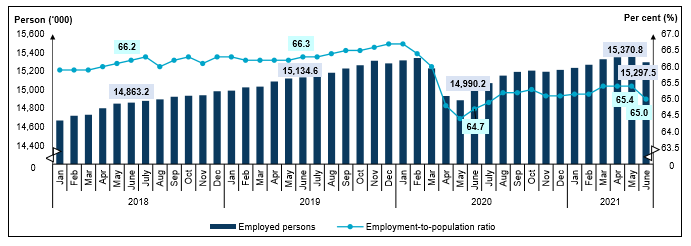
The largest composition of employed persons was employee’s category with 77.6 per cent. This category reduced by 56.7 thousand persons (-0.5%) to 11.87 million persons as compared to the previous month (May 2021: 11.93 million persons). Meanwhile, own-account workers which comprised mostly of daily income earners working as small business operators such as small retailers; hawkers; sellers in markets and stalls as well as smallholders, recorded an addition of 4.1 thousand persons to 2.50 million persons (May 2021: 2.49 million persons). The slight increase in this group was partly due to the permission of small businesses such as food or beverage stalls or hawkers to operate during the Full MCO period. [Chart 2]
Chart 2: Employed person by status of employment, May and June 2021
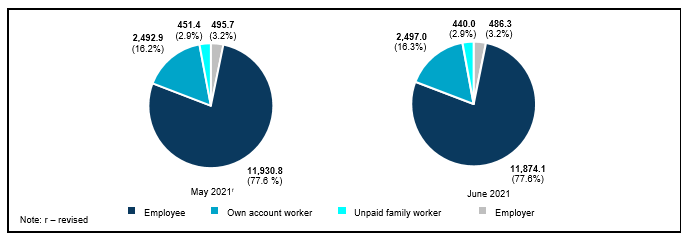
Following the implementation of Full MCO throughout the month which allowed only essential economic and services sector to operate has caused the number of employed persons who were temporarily not working in June 2021 registered a significant increased by 661.4 thousand persons to record 801.1 thousand persons as against May 2021 (139.6 thousand persons). A similar situation was observed during the first implementation of MCO in March until May last year whereby an upsurge number of employed persons who were temporarily not working recorded. In comparison to June 2020, the number of employed persons in this category continuously declined (-11.9%) from 908.9 thousand persons. This group of persons, who were most likely not able to work was not categorised as unemployed as they had work to return to.
The unemployment rate climbed to 4.8 per cent in June 2021
The unemployment rate in June 2021 climbed to 4.8 per cent (May 2021: 4.5%) after four consecutive months of decreases. The number of unemployed persons escalated by 40.6 thousand persons (+5.6%) to 768.7 thousand persons (May 2021: 728.1 thousand persons).
Year-on-year comparison, the unemployment rate edged down by 0.1 percentage points as compared to 4.9 per cent in June 2020 while the number of unemployed persons lessened by 4.6 thousand persons (June 2020: 773.2 thousand persons). [Chart 3]
Chart 3: Unemployed persons and unemployment rate, 1982 - 2020 and January 2020 - June 2021

During the month, the actively unemployed or those who were available for work and were actively seeking job encompassed 83.6 per cent of the total unemployed persons. This number went up by 33.0 thousand persons to record 642.9 thousand persons (May 2021: 609.9 thousand persons). Those who were unemployed for less than three months accounted for 52.3 per cent of the actively unemployed while 9.8 per cent was those who were in long-term unemployment of more than a year1. A similar trend was also witnessed in the inactively unemployed who believed that there were no jobs available with an addition of 7.6 thousand persons (+6.4%) to 125.8 thousand persons (May 2021: 118.2 thousand persons). [Chart 4]
Chart 4: Unemployed category and duration of unemployment, May and June 2021

The youth unemployment rate for aged 15 to 24 years during the month was lowered by 0.9 percentage points to 12.7 per cent as against to the previous month (May 2021: 13.6%). The number of unemployed youths rose by 12.9 thousand persons to record 340.9 thousand persons (May 2021: 328.1 thousand persons). In the meantime, the youth unemployment rate for youth aged 15 to 30 years posted an increase of 0.2 percentage points to 9.4 per cent during the month (May 2021: 9.2%). [Chart 5]
Chart 5: Unemployment rate by selected age groups, 1982 - 2020 and January 2020 - June 2021
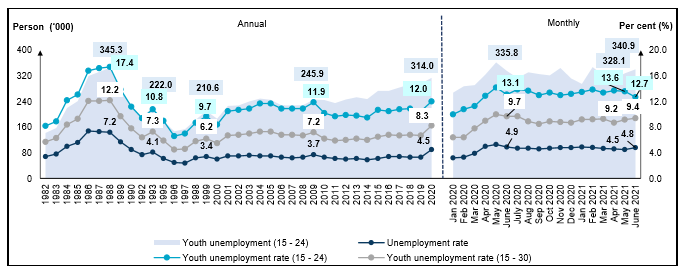
Lower LFPR registered in June 2021 at 68.3 per cent
In June 2021, the number of labour force declined by 32.8 thousand persons to 16.07 million persons (May 2021: 16.10 million persons) and this was the first decrease of labour force recorded since April 2020 as the pandemic hit the country. Accordingly, lower labour force participation rate (LFPR) was registered at 68.3 per cent (May 2021: 68.5%).
Year-on-year, the number of labour force increased by 302.7 thousand persons (1.9%) as against 15.76 million persons registered in June 2020. Similar trend was recorded in LFPR which was up by 0.2 percentage points from the previous year (June 2020: 68.1%). [Chart 6]
Chart 6: Labour force and LFPR, 1982 – 2020 and January 2020 - June 2021
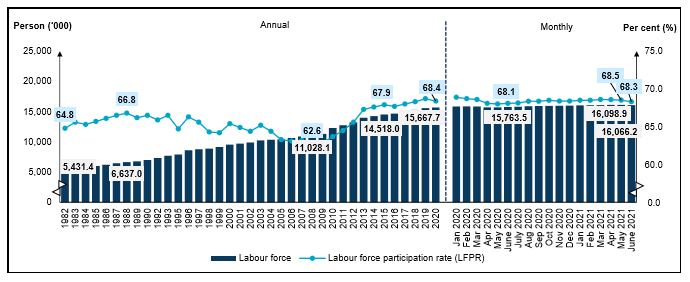
Male LFPR registered an upward trend with an addition of 0.5 percentage points to record 81.6 per cent, but female LFPR was unchanged at 55.2 per cent. For three consecutive months, the number of male labour force was in a declining trend of which in June 2020 the number declined by negative 2.9 per cent (-280.5 thousand persons) to 9.51 million persons (May 2021: 9.79 million persons). In the meantime, female labour force remained its positive month-on-month growth of 3.9 per cent (+247.8 thousand persons) to 6.55 million persons (May 2021: 6.31 million persons). In comparison with the twelve months earlier, both male and female LFPR heightened by 1.4 percentage points and 0.1 percentage point from 80.3 per cent and 55.1 per cent respectively. [Chart 7]
Chart 7: Labour force and LFPR by sex, 1982 - 2020 and January 2020 – June 2021
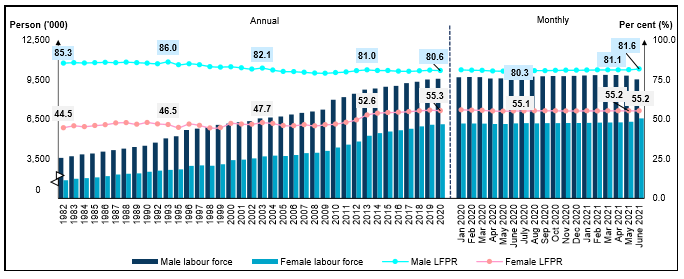
The largest category of outside labour force was housework/ family responsibilities
The number of outside labour force in June 2021 continued to increase for the third month, thereby recorded an addition of 58.8 thousand persons (0.8%) to 7.46 million persons (May 2021: 7.40 million persons). Similarly, the number of outside labour force rose by 58.3 thousand persons (0.8%) year-on-year. The largest category of outside labour force was due to the housework/ family responsibilities which comprised of 47.3 per cent and followed by schooling/ training category with 38.9 per cent. [Chart 8]
Chart 8: Share of outside labour force by reasons for not seeking work, May and June 2021
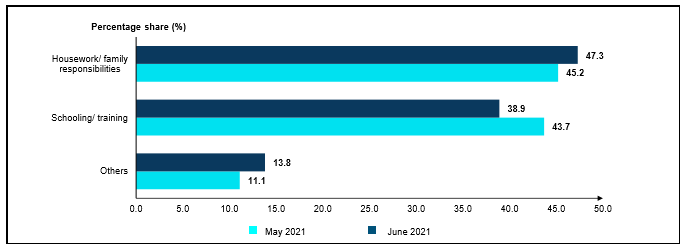
GOVERNMENT’S INITIATIVES2
Various government initiatives had been implemented to assist each and every layer of the targeted group. The Wage Subsidy Programme (PSU 1.0) under PRIHATIN and PENJANA had been approved to 322,177 employers and benefitted 2.64 million registered employees as of 9 July 2021 with a value of RM12.91 billion. Meanwhile, a total of RM1.31 billion has been disbursed to 76,083 employers to support bussiness operation and retain employment for 669,289 employees under the Wage Subsidy Programme (PSU) 2.0. Moreover, through the Hiring Incentive Programme and Training Assistance, there were 137,659 employees had secured employment particularly in Manufacturing and Wholesale and retail trade industries. As for the Reskilling and Upskilling Programme, a total of 149,791 persons had been approved to participate in course provided.
A total of RM12.26 billion of Small, Medium Enterprise (SME) soft loan fund has been approved by local banks which aided 25,894 SMEs. This fund includes Special Relief Facility (SRF), Automation & Digitalisation Facility (ADF), All-Economic Sector Facility (AES) and Agrofood Facility (AF) funds. Subsequently, a total of RM66.1 million funds were approved for 332 SMEs applications under PENJANA Tourism Financing. This fund was allocated for the affected SMEs and micro-SMEs by the COVID-19 pandemic. Furthermore, a total of 749 SMEs had been benefited through the Bumiputera Relief Financing (BRF) with a total of RM226.8 million funds as of 2nd July 2021. Meanwhile, a total of RM421.2 million had been channelled to aid 12,667 Micro SMEs including in the Retail and Services sectors through the PENJANA Micro Credit Financing as of 9th July 2021. To support the Agriculture and Food Industry, 13,871 Agricultural Micro SMEs which includes farmers, planters and fishermen had been aided involving a total value of RM171.64 million funds under the Agrobank Microcredit Financing Scheme.
Next, there were 13,873 businesses had been aided involving RM76.62 million to support the Technical and Digital Mid-tier Companies (MTCs) and Digital Adaption. In addition, a total value of RM4.26 million has been channelled to 520 recipients including artists, collectives and organisations which were actively involved in the Malaysian arts and culture industry through the CENDANA initiative.
LOOKING AHEAD
The National Recovery Plan (NRP) or total lockdown which took effect on 29 June 2021 is continued for the second month across the country. Stricter containment measures were executed to stifle the infection of the COVID-19 which had exceeded 11,000 of new cases daily starting in the middle of July 2021. Beginning 5 July, several states were moved into Phase 2 namely Perlis, Kelantan, Terengganu, Pahang, Perak. Subsequently, Pulau Pinang, Sabah and Sarawak were also in Phase 2 NRP effective 7 July onwards.
The health crisis persists as the country is still combatting the rising number of new daily COVID-19 cases. This has led the economy and labour market continuously experiencing uneven recovery. Therefore, herd immunity is essential towards loosening up the containment measures, thus allowing businesses to
resume their operation. The National COVID-19 Vaccination Programme is speeding up the pace hence it may boost the households and businesses confidence to stimulate the economic activity. Moreover, various initiatives are also funded to support business continuity through Pakej Pelindungan Rakyat dan Pemulihan Ekonomi (PEMULIH). With these programmes, the economy and labour market activities may rebound, not considering the new and more lethal COVID-19 variants.
TECHNICAL NOTES
This information is derived from the Labour Force Survey (LFS) which was conducted to collect information on the structure and distribution of labour force, employment and unemployment.
The survey population cover persons who live in private living quarters and excludes persons residing in institutions such as hotels, hostels, hospitals, prisons, boarding houses and workers residing in construction work site.
The survey comprises of the economically active and inactive population. To measure the economically active population, the LFS uses the age limit of 15 to 64 years. The economically active population comprises of those employed and unemployed whereas those who are inactive is classified as outside the labour force.
LFS uses the actual status approach, where a person is classified on the basis of his labour force activity during the reference week.
- Labour force refers to those who, during the reference week are in the 15 to 64 years (in completed years at last birthday) and who are either employed or unemployed.
- Employed refers to all persons who, at any time during the reference week worked at least one hour for pay, profit or family gain (as an employer, employee, own-account worker or unpaid family worker). Also considered as employed are persons who did not work during the reference week because of illness, injury, bad weather, leave, labour dispute and social or religious reasons but had a job, farm, enterprise or other family enterprise to return to. Also included are those on temporary lay-off with pay who would definitely be called back to work.
- Unemployed
Unemployed refers to those who do not have a job but are interested to work. There are two groups of unemployed that is the actively unemployed and inactively unemployed.
- Outside Labour Force
All persons not classified as employed or unemployed as stated above are classified as outside labour force. Includes housewives, students (including those going for further studies), retired, disabled persons and those not interested in looking for a job.
- Labour Force Participation Rate
The economic activity of a population depends on the demographic characteristics of that population. The proportion of economically active population, therefore, differs between sub-groups of that population. These variations are measured by specific activity rates termed as labour force participation rate. Labour force participation rate is defined as the ratio of the labour force to the working age population (15 to 64 years), expressed as percentage.
- Unemployment rate is the proportion of unemployed population to the total population in labour force. This rate measures the percentage of unemployed population in the labour force.
Population by characteristics of age group, ethnicity and state were used as benchmarks to produce labour statistics.
Starting with the monthly release of the Principal Statistics of Labour Force, Malaysia, January 2016, the principal statistics of labour is estimated based on the current population estimates as compared to the previous series which used population projections based on the Population and Housing Census of Malaysia, 2010. This rebase is to obtain statistics that is more consistent with current population structure.
The full publication of the Labour Force Report, June 2021. This report is accessible and downloadable through the application eStatistik Portal, Free Download
For more details, please refer to the Department’s portal: www.dosm.gov.my
Released By:
DATO' SRI DR. MOHD UZIR MAHIDIN
CHIEF STATISTICIAN MALAYSIA
DEPARTMENT OF STATISTICS, MALAYSIA


9 August 2021
Contact person:
Mohd Yusrizal bin Ab. Razak
Public Relation Officer
Strategic Communication and International Division
Department of Statistics, Malaysia
Tel : +603-8885 7942
Fax : +603-8888 9248
Email : yusrizal.razak@dosm.gov.my
Subscribe
Newsletter
Subscribe to our newsletter and stay updated
For interviews, press statement and clarification to the media, contact:
Baharudin Mohamad
Public Relation Officer
Email: baharudin[at]dosm.gov.my
Phone: 03 8090 4681
Not found what you looking for? Request data from us, through
Go to eStatistik
Email: data[at]dosm.gov.my
Phone: 03 8885 7128 (data request)










